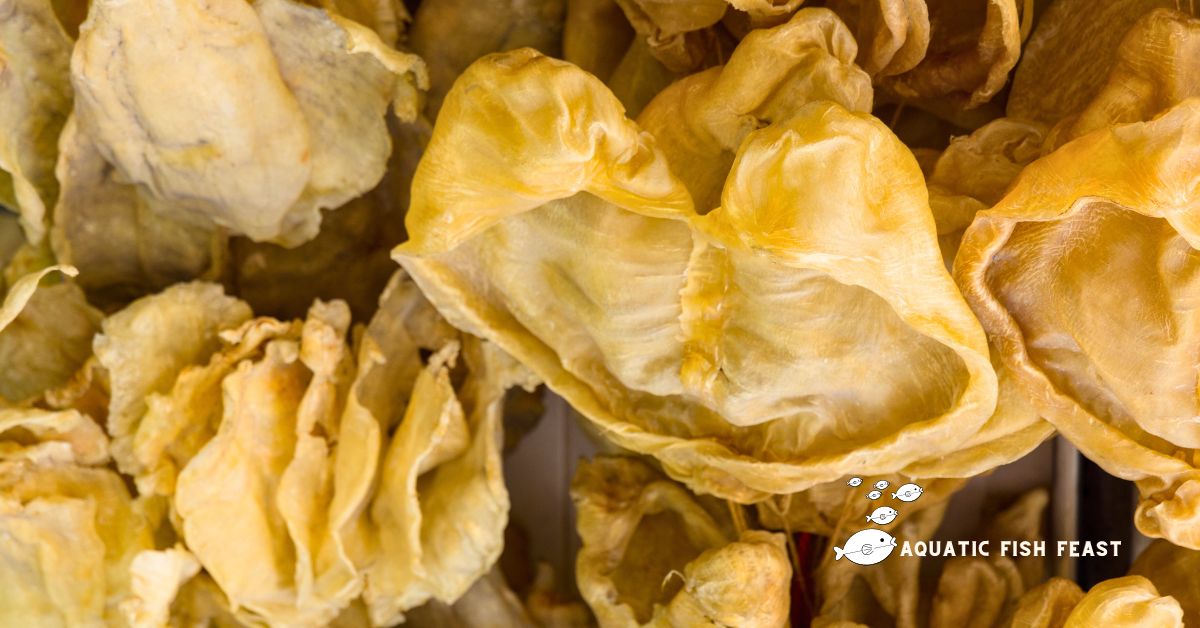Do you want to know how to dry fish maw? Fish maw, which many people often regard as the “treasure of the sea,” could be because of its great role in many culinary traditions, especially in Asian cuisines.
With their taste and flavor, fish maws make excellent additions to soups, stews, and stir-fries.
Today, my dear friends, we shall examine how to dry fish maw and discover the secrets of why it is one of the best culinary delights.
Now, let’s get started.
Table of Contents
How To Dry Fish Maw
Knowing how to dry fish maw is quite an interesting process because I have done it many times, both on small and large scales.
However, it is better to familiarize ourselves with fish maw before we continue the drying process.
The fish maw can also be called the swim bladder of fish. Many cooks love its rich collagen gem that helps add depth and flavor to various meals.
It is also known that the fish maw is a symbol of fortune in Chinese cuisine and is usually served during banquets.
Proper preparation is very important before you start drying your fish maw.
It’s important to carefully remove any impurities or membranes clinging to the surface of the fish maw.
Ensure you thoroughly rinse under cold water and make it completely free from any residue.
For the best results, you may consider soaking the fish maw in water first for some time to soften its texture. This will make your drying process perfect.
The fish maw drying process
Traditional fish maw drying involves sun-drying and air-drying. Put the fish maw on a clean surface and let the sun dry it.
Remember, you must always turn the other side by flipping it occasionally for perfect drying.
Alternatively, you can also use hanging, which is the air-drying method. You hang the fish maw in a well-ventilated area, allowing air to pass over it gently over time.
However, a food dehydrator is the best option for those who prefer modern convenience.
These devices enable precise control over temperature and airflow, speeding up the drying process without compromising quality.
Tips To Ensure Proper Fish Maw Drying
Properly drying fish maws is crucial to help preserve their delicate flavor and prevent spoilage. Look for signs of complete dryness, such as a brittle texture and the absence of moisture.
Sometimes, the drying process should last four more hours at 30°C. Total usage is 6-7 hours. When it has had a chance to dry out, the fish jaw will become tough.
Avoid common pitfalls, such as insufficient drying time or exposure to moisture. They can compromise the quality of the end product. Dry the area for two hours at 20 degrees Celsius and 10% humidity.
Why Do People Dry Fish
Fish has been dried for thousands of years to preserve it.
Organized commercial fishing in the 15th and 16th centuries made this element important.
The fishermen desperately needed a solution to preserve the quality of their catch while being transported to several ports.
Salting and curing their fish was an excellent strategy. Drying fish is a traditional method of food preservation used by indigenous peoples and tribes across Canada. This time-honored practice continues today.
In point of fact, throughout human history, the majority of coastal cultures all over the world have developed their very particular styles of dried fish. For instance, in the Philippines, they call their dried fish “Daing,” meaning “sun-baked or sun-dried.”
This meal is still quite popular in modern times and is frequently had for breakfast alongside rice. However, due to the dish’s adaptability, it may be included in various meals and ways of cooking.
What Is The Best Method Of Drying Fish
The best fish drying methods are as follows: Beginners should dry fish in an oven or dehydrator.
Adjust the oven temperature to 160–180 degrees Fahrenheit, depending on the fish size.
Fish should be scaled, gutted, and cleaned on all sides. Any defective fish parts left intact would hinder drying.
Salt the fish on both the interior and the outside. A coarse-grained salt such as kosher is recommended.
Put the fish on a wire rack and a dish beneath it to catch any juices running off.
Bake the fish for fifteen minutes at the temperature you have chosen.
After turning off the heat, put the fish in the oven for twenty-four hours without covering it.
Steps 5 and 6 should be repeated daily for the next four days.
Once everything is finished, check on the fish. If they don’t appear completely dry after a week in the oven, give them another day or two.
Use a vacuum sealer or a container that won’t let air in when storing your fish.
How Do You Make Fish Dry Faster
Other drying methods include osmotic dehydration, sun drying, solar drying, heat pump drying, freeze drying, and sun drying.
Dried fish product quality depends on storage conditions, packing methods, and materials.
Dried food sales are rising rapidly. The main drying processes include thermal, osmotic, mechanical, chemical, and mechanical.
Fish drying includes complex transient heat, mass, and momentum movement. Heat is used to fish muscles to remove water.
Drying removes water from fish muscle fibers.
The preservation of food relies heavily on the functioning of water systems. It has been utilized to assess microbial growth, lipid oxidation, non-enzymatic and enzymatic activity, and the texture of various meals.
What Chemicals Are Used To Dry Fish
Nitrite, sulfur dioxide, benzoic acid, and sorbic acid are chemical drying agents (preservatives) that can be utilized in fisheries.
These preservatives have unique effects on the microbes they are designed to combat. Food characteristics, such as pH and aw, are among the most essential elements that determine the antibacterial action of an antibiotic.
Preserving food goods, especially fishery products, is prevalent in processed food products. Not only does preserving food serve to preserve its quality, but it also extends the amount of time that food may be kept on a store shelf.
Natural and chemical preservation methods are the two categories that may be used to classify preservatives.
What Are The Benefits Of Drying Fish
The following are some potential health advantages of dried fish based on its nutrients.
1. Contains good fat
Dried fish is high in omega-3 fatty acids. These are the healthful fats that our bodies require.
They’re “good fats,” unlike meat’s deadly saturated fats.
Omega-3 fatty acids decrease inflammation, improve heart health, and boost cognitive function.
2. Beneficial to the heart
Dried fish provides heart-healthy lipids, omega-3 fatty acids, and minerals. These nutrients aid in the correct heart functioning and lower the risk of heart disease.
Omega-3 fatty acids are particularly advantageous to the heart, having been demonstrated to decrease cholesterol, blood pressure, and triglyceride levels. They can also assist in preventing strokes and arrhythmias (irregular heartbeats).
3. Excellent source of vitamin D
Vitamin D is abundant in dried fish. Healthy bones and teeth depend on vitamin D, which helps the body absorb calcium.
4. High Protein, Low Calorie Diet
Protein is an essential supply of antibodies and enzymes for all living things and an essential component of muscles, hair, and other biological components.
Dried fish has fewer calories than other foods like steak but still provides a great dose of protein. One hundred grams of dried fish has around 80% protein and 300 calories, whereas beef contains more than double the calories and significantly less protein.
This feature makes dried fish an appealing buy for consumers trying to boost their consumption of nutritious food – and gives dried-fish dealers a particular edge.
Final Thought
Now that we have established how to dry fish maw, depending on your method, you may add a Smokey flavor or go for the conventional salted and dried style.
With the knowledge and techniques shared in this post, you can confidently transform your fresh fish maw into a culinary demand.
Dip the fish in spicy vinegar if you want to add flavor. Sprinkle chili flakes or use them as a dry rub over the fish while it’s seasoned.
Remember that the key to properly drying your fish maw is cleaning it with clean water, adding salt, and removing as much moisture as possible. Then, proceed to the dry methods.
Other Articles:




